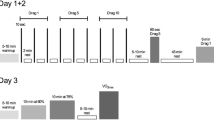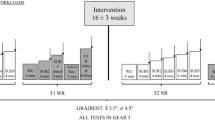Summary
Two experiments were carried out to compare the cardiorespiratory and metabolic effects of cross-country skiing and running training during two successive winters. Forty-year-old men were randomly assigned into skiing (n = 15 in study 1,n = 16 in study 2), running (n = 16 in study 1 andn = 16 in study 2) and control (n = 17 in study 1 andn = 16 in study 2) groups. Three subjects dropped out of the programme. The training lasted 9–10 weeks with 40-min exercise sessions three times each week. The training intensity was controlled at 75%–85% of the maximal oxygen consumption (VO2max) using portable heart rate metres and the mean heart rate was 156–157 beats·min−1 in the training groups. In the pooled data of the two studies the mean increase in theVO2max (in ml·min−1·kg−1) on a cycle ergometer was 17% for the skiing group, 13% for the running group and 2% for the control group. The increase inVO2max was highly significant in the combined exercise group compared to the control group but did not differ significantly between the skiing and running groups. The fasting serum concentrations of lipoproteins and insulin did not change significantly in any of the groups. These results suggested that training by cross-country skiing and running of the same duration and intensity at each session for 9–10 weeks improved equally the cardiorespiratory fitness of untrained middle-aged men.
Similar content being viewed by others
References
Åstrand P-O, Saltin B (1961) Maximal oxygen uptake and heart rate in various types of muscular activity. J Appl Physiol 16:977–981
Åstrand P-O, Rodahl K (1986) Textbook of work physiology: physiological bases of exercise. 3rd edn. McGraw-Hill, New York, pp 661–665
Blomqvist CG, Saltin B (1983) Cardiovascular adaptations to physical training. Annu Rev Physiol 45:169–189
Borg GAV (1982) Psychophysical bases of perceived exertion. Med Sci Sports Exerc 14:377–381
Christensen EH, Högberg P (1950) Physiology of skiing. Arbeitsphysiologie 14:292–303
Eisenman PA, Johnson SC, Cynthia N (1989) Applied physiology of cross-country skiing. Sports Med 8:67–79
Enger SC, Herbjørnsen K, Erikssen J, Fretland A (1977) High density lipoproteins (HDL) and physical activity: the influence of physical exercise, age and smoking on HDL-cholesterol and the HDL-/total cholesterol ratio. Scand J Clin Lab Invest 37:251–255
Gettman LR, Pollock ML, Durstine JL, Ward A, Ayres J, Linnerud AC (1976) Physiological responses of men to 1, 3, and 5 days per week training programs. Res Q 47:638–646
Haskell WL (1986) The influence of exercise training on plasma lipids and lipoproteins in health and disease. Acta Med Scand [Suppl] 711:25–37
Izzo G, Grillo F, Murador E (1981) Improved method for determination of high-density-lipoprotein cholesterol. I. Isolation of high-density lipoproteins by use of polyethylene glycol 600. Clin Chem 27:371–374
Lehtonen A, Viikari J (1978) Serum triglycerides and cholesterol and serum high-density lipoprotein cholesterol in highly physically active men. Acta Med Scand 204:111–114
Lieber DC, Lieber RL, Adams WC (1989) Effects of run-training and swim-training at similar absolute intensities on treadmillVO2max. Med Sci Sports Exerc 21:655–661
Millerhagen JO, Kelly JM, Murphy RJ (1983) A study of combined arm and leg exercise with application to Nordic skiing. Can J Appl Sports Sci 8:92–97
Nagle FJ, Richie JP, Giese MD (1984)VO2max responses in separate and combined arm and leg air-braked ergometer exercise. Med Sci Sports Exerc 16:563–566
Ng AV, Demment RB, Bassett DR, Bussan MJ, Clark RR, Kuta JM, Schauer JE (1988) Characteristics and performance of male citizen cross-country ski racers. Int J Sports Med 9:205–209
Norman R, Caldwell G, Komi P (1985) Differences in body segment energy utilization between world-class and recreational cross-country skiers. Int J Sport Biom 1:253–262
Oja P (1983) Comparison of the physiological effects of different forms of physical activity. Finn Sports Exerc Med 2:62–71
Oja P, Kukkonen-Harjula K, Nieminen R, Vuori I, Pasanen M (1988) Cardiorespiratory strain of middle-aged men in mass events of long-distance cycling, rowing, jogging, and skiing. Int J Sports Med 9:45–51
Peltonen P, Marniemi J, Hietanen E, Vuori I, Ehnholm C (1981) Changes in serum lipids, lipoproteins, and heparin releasable lipolytic enzymes during moderate physical training in man: a longitudinal study. Metabolism 30:518–526
Pollock ML, Dimmick J, Miller HS Jr, Kendrick Z, Linnerud AC (1975) Effects of mode of training on cardiovascular function and body composition of adult men. Med Sci Sports 7:139–145
Rauramaa R, Salonen JT, Kukkonen-Harjula K, Seppänen K, Seppälä E, Vapaatalo H, Huttunen JK (1984) Effects of mild physical exercise on serum lipoproteins and metabolites of arachidonic acid: a controlled randomised trial in middle aged men. Br Med J 288:603–606
Reybrouck T, Heigenhauser GF, Faulkner JA (1975) Limitations to maximum oxygen uptake in arm, leg, and combined armleg ergometry. J Appl Physiol 38:774–779
Rusko H, Havu M, Karvinen E (1978) Aerobic performance capacity in athletes. Eur J Appl Physiol 38:151–159
Rusko HK, Rahkila P (1981) Effects of increased intensity of training on maximum oxygen uptake and muscular performance of young female cross-country skiers. In: Borms J, Hebbelinck M, Venerando A (eds) Women and sport: an historical, biological, physiological and sportsmedical approach. Karger, Basel, pp 187–194
Saltin B (1986) Physiological adaptation to physical conditioning, old problems revisited. Acta Med Scand [Suppl] 711:11–24
Saltin B, Åstrand P-O (1967) Maximal oxygen uptake in athletes. J Appl Physiol 23:353–358
Schriewer H, Günnewig V, Assmann G (1983) Effect of 10 weeks endurance training on the concentration of lipids and lipoproteins as well as on the composition of high-density lipoproteins in blood serum. Int J Sports Med 4:109–115
Thetford JL (1984) The effects of jogging and simulated cross-country skiing as modes for improving max O2 uptake and body composition in college-aged males. Thesis, Texas Women's University, Denton, Texas. Available at University Microfilms International, Ann Arbor, Michigan, pp 1–90
Vuori I (1977) Feasibility of long-distance (20–90 km) skihikes as a mass sport for middle-aged and old people. In: Harris R, Frankel JL (eds) Guide to fitness after fifty. Plenum Press, New York, pp 95–142
Wenger HA, Bell GJ (1986) The interactions of intensity, frequency and duration of exercise training in altering cardiorespiratory fitness. Sports Med 3:346–356
Wilmore JH, Davis JA, O'Brien RS, Vodak PA, Walker GR, Amsterdam WA (1980) Physiological alterations consequent to 20-week conditioning programs of bicycling, tennis, and jogging. Med Sci Sports Exerc 12:1–8
Author information
Authors and Affiliations
Rights and permissions
About this article
Cite this article
Oja, P., Laukkanen, R.M.T., Kukkonen-Harjula, T.K. et al. Training effects of cross-country skiing and running on maximal aerobic cycle performance and on blood lipids. Europ. J. Appl. Physiol. 62, 400–404 (1991). https://doi.org/10.1007/BF00626610
Accepted:
Issue Date:
DOI: https://doi.org/10.1007/BF00626610




